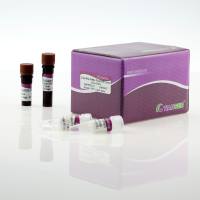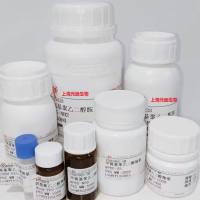Taq-polymerase catalyzed cycle sequencing using fluorescent-labeled dye primers
互联网
Each base-specific fluorescent-labeled cycle sequencing reaction routinely included approximately 100 or 200 ng Biomek isolated single-stranded DNA for A and C or G and T reactions, respectively. Double-stranded cycle sequencing reactions similarly contained approximately 200 or 400 ng of plasmid DNA, isolated using either the standard alkaline lysis or the diatomaceous earth modified alkaline lysis procedures. All reagents except template DNA are added in one pipetting step from a premix of previously aliquotted stock solutions stored at -20degC (see Appendix B). To prepare the reaction premixes, reaction buffer is combined with the base-specific nucleotide mixes. Prior to use, the base-specific reaction premixes are thawed and combined with diluted Taq DNA polymerase and the individual fluorescent end-labeled universal primers (see Appendix C) to yield the final reaction mixes, that are sufficient for 24 template samples.
Once the above mixes are prepared, four aliquots of single or double-stranded DNA are pipetted into the bottom of each 0.2 ml thin-walled reaction tube, corresponding to the A, C, G, and T reactions, and then an aliquot of the respective reaction mixes is added to the side of each tube. These tubes are part of a 96-tube/retainer set tray in a microtiter plate format, which fits into a Perkin Elmer Cetus Cycler 9600. Strip caps are sealed onto the tube/retainer set and the plate is centrifuged briefly. The plate then is placed in the cycler whose heat block had been preheated to 95deg C, and the cycling program immediately started. The cycling protocol consisted of 15-30 cycles of seven-temperatures:
95degC denaturation
55degC annealing
72degC extension
95degC denaturation
72degC extension
95degC denaturation, and
72degC extension, linked to a 4deg C final soak file.
At this stage, the reactions frequently are frozen and stored at -20degC for up to several days. Prior to pooling and precipitation, the plate is centrifuged briefly to reclaim condensation. The primer and base-specific reactions are pooled into ethanol, and the DNA is precipitated and dried. These sequencing reactions could be stored for several days at -20degC.
Protocol
1. Pipette 1 or 2 ul of each DNA sample (100 ng/ul for M13 templates and 200 ng/ul for pUC templates) into the bottom of the 0.2 ml thin-walled reaction tubes (Robbins Scientific). Use the 1 ul sample for A and C reactions, and the 2 ul sample for G and T reactions. Meanwhile, preheat the PE Cetus Thermocycler 9600 to 95degC (Program #2).
2. Prepare the Taq polymerase dilution. AmpliTaq polymerase (N801-0060) is from Perkin-Elmer Cetus.
30ul AmpliTaq (5U/ul)
30ul 5X Taq reaction buffer
130ul ddH20
190ul diluted Taq for 24 clones
3. Prepare the A, C, G, and T base specific mixes by adding base-specific primer and diluted Taq to each of the base specific nucleotide/buffer premixes:
A,C/G,T
60/120ul 5X Taq cycle sequencing mix
30/60ul diluted Taq polymerase
30/60ul respective fluorescent end-labeled primer
120/240ul
[1] [2] 下一页









